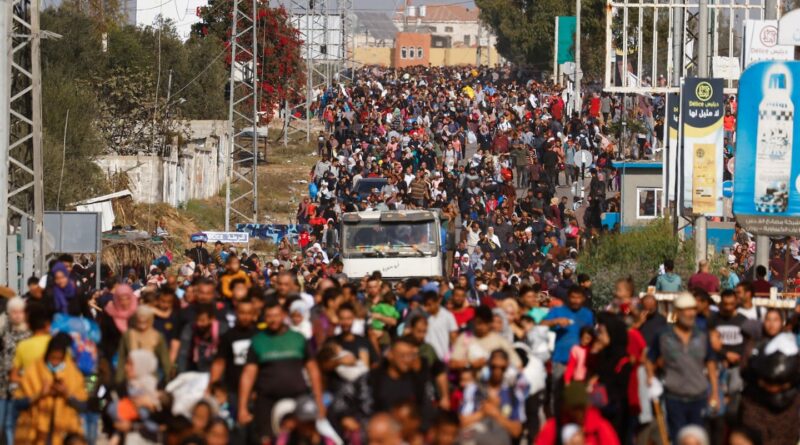Fighting rages around Gaza’s hospitals as U.S. cautions over civilian losses
The Israel Defense Forces confirmed it had surrounded several hospitals and demanded they be evacuated, according to Israel Army Radio.
U.S. Secretary of State Antony Blinken said from New Delhi on Friday that “far too many Palestinians have been killed. Far too many have suffered these past weeks,” and he said discussions were underway with Israel about “concrete steps” it could take to minimize civilian casualties.
The IDF, however, insists that the hospitals are also Hamas strongholds. It has issued steady progress reports for its battles in Gaza City, describing the deaths of dozens of militants as well as compounds captured and weapons factories uncovered.
Under international pressure, Israel announced a policy of midday pauses in the fighting for four hours so that the remaining residents of Gaza City and the north of the Gaza Strip can escape southward — though strikes are taking place in all parts of the enclave.
In response to a Hamas incursion on Israeli communities around the Strip on Oct. 7 that killed at least 1,400 Israelis and took more than 240 hostages, Israel has unleashed a blistering attack on the Gaza Strip that so far has claimed more than 11,000 lives, including thousands of children.
The attack has focused on Gaza City, the most populous area in the Gaza Strip before the war, because Israel said it is a focus of Hamas weapons and infrastructure. Tens of thousands have taken advantage of the pauses in fighting to flee, with 50,000 leaving on Thursday alone, according to the U.N. humanitarian affairs agency. An estimated 900,000 have packed into the increasingly overcrowded south since the start of the conflict.
The World Health Organization on Friday confirmed reports that al-Shifa Hospital, the largest in the city, has come under bombardment. Mohamed Abu Salmiya, the director general, told Al Jazeera that there had been at least four strikes on it by Friday.
On Thursday evening an artillery shell crashed into the complex, injuring at least two people. “We were trying to sleep, and a number of journalists were filming the general atmosphere, specifically that the artillery shelling and sounds of clashes did not stop,” said Amr Abu Nada, was standing nearby inside the journalists’ tent. “Suddenly we heard the sounds of a shell that caused terror among our ranks and surprised everyone.”
The Gaza Health Ministry also said there had been “direct attacks and bombardments” around the al-Rantisi Pediatric Hospital since Thursday that had left it cut off.
Shahad al-Sharafa, 18, who has been sheltering at the hospital, said on Thursday night by phone that strikes had set alight several ambulances in the hospital’s yard. She said that the displaced living there tried to put out the fires, as emergency crews could not immediately reach the facility due to ongoing bombardments and street fighting.
In a message Friday morning, Sharafa then said that the shelling and gunfire continued through the night and into the morning, and that the communication outages make it difficult to get the word out to tell people to stay away from the hospital.
The nearby al-Nasr Hospital has also come under fire. In a video posted on X, the site formerly known as Twitter, and geolocated by The Post, a crowd of civilians, including many children, can be seen attempting to leave through one of the hospital’s gates while waving white flags. As the group begins to move through the gate and onto the street three gunshots can be heard, forcing them to retreat back into the hospital grounds. The Post could not confirm the source of the shots.
Later on Friday, the three nearby hospitals — al-Nasr, al-Rantisi and the Gaza Eye Hospital — that had been surrounded by the fighting were evacuated after being given a route by the IDF.
“We were carrying white flags and when we walked out, we passed by the tanks, I was meters away from one,” said Baqr Qaoud, director of the Nasr Hospital. He said some 4,000 people left and he was the last doctor to walk out of the hospital. He watched tanks close in on his hospital as he departed.
Across Gaza City, panic is fast spreading as thousands of people make desperate dashes for safety. Since Sunday, more than 120,000 have fled south by foot from Gaza City and the enclave’s northern half, according to OCHA, the U.N. humanitarian agency. It’s an arduous, hours-long journey by foot along a road lined with tanks and decaying bodies, Gazans who have made the trip told The Post.
A 37-year-old mother of three in Gaza City, who spoke on the condition of anonymity for fear of her security, said by phone that she was desperate to flee her neighborhood in western Gaza City filled with the sounds of gunshots, airstrikes and screams. She considered going east, where she heard it was safer, but didn’t know how to decide.
“We don’t know where to go,” she said, “but what is important that we leave this area.”
“We just wait for our destiny,” Mohammed Shaqra, 29, a Gaza City resident who planned to stay said in a “farewell” WhatsApp message. “May God protect the people of Gaza.”
The U.N. High Commissioner for Human Rights Volker Türk, who has condemned atrocities on both sides which he says constitute war crimes, called for an investigation into what he called Israel’s use of “high-impact explosive weapons” in Gaza. Speaking in the Jordanian capital Amman, he said the weapons were “razing” buildings to the ground and causing indiscriminate destruction in densely populated areas. “We have very serious concerns that these amount to disproportionate attacks in breach of international humanitarian law,” he added, while reiterating calls for a cease-fire.
Israel has vowed to utterly destroy the Hamas militant movement which has controlled the Gaza Strip since 2006, but it is not clear what would come afterward.
The United States has insisted the enclave cannot be reoccupied by Israel and has to be governed by the Palestinians, though it has acknowledged that Israel forces could be there for an interim period.
What comes next, however, is unclear, with Israeli Prime Minister Benjamin Netanyahu saying at one point that Israel would take over overall security responsibility for “an indefinite period.”
On Thursday night, however, he told Fox News that “we don’t seek to conquer Gaza, we don’t seek to occupy Gaza, and we don’t seek to govern Gaza.”
Palestinian leader Mahmoud Abbas, whose Fatah party controls pockets of the Israeli-occupied West Bank, said he would be willing to administer the Gaza Strip as part of a comprehensive political settlement for all Palestinian areas, according to Reuters. Abbas, however, is deeply unpopular among many Palestinians.
Schemm reported from London. Michael Birnbaum in New Delhi and Hajar Harb and Imogen Piper in London contributed to this report.



